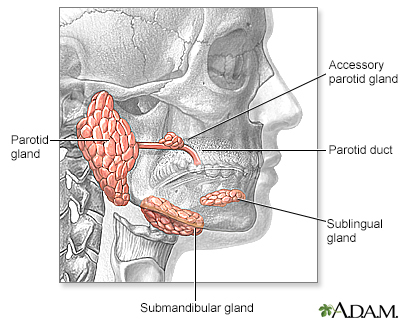Salivary gland tumors
Definition
Salivary gland tumors are abnormal cells growing in the gland or in the tubes (ducts) that drain the salivary glands.
Alternative Names
Tumor - salivary duct
Causes
The salivary glands are located around the mouth. They produce saliva, which moistens food to help with chewing and swallowing. Saliva also helps to protect teeth from decay.
There are 3 main pairs of salivary glands. The parotid glands are the largest. They are located in each cheek in front of the ears. Two submandibular glands are under the floor of the mouth under both sides of the jaw. Two sublingual glands are under the floor of the mouth. There are also hundreds of small salivary glands lining the rest of the mouth. These are called the minor salivary glands.
Salivary glands empty saliva into the mouth through ducts that open at various places in the mouth.
Salivary gland tumors are rare. Swelling of the salivary glands is mostly due to:
- Major abdominal and hip repair surgeries
- Cirrhosis of the liver
- Infections
- Other cancers
- Salivary duct stones
- Salivary gland infections
- Dehydration
- Sarcoidosis
- Sjögren syndrome
The most common type of salivary gland tumor is a slow-growing noncancerous (benign) tumor of the parotid gland. The tumor gradually increases the size of the gland. Some of these tumors can be cancerous (malignant).
Symptoms
Symptoms may include any of the following:
- Firm, usually painless swelling in one of the salivary glands (in front of the ears, under the chin, or on the floor of the mouth). The swelling gradually increases.
- Difficulty moving one side of the face, known as facial nerve palsy.
Exams and Tests
An examination by a health care provider or dentist shows a larger than normal salivary gland, usually one of the parotid glands.
Tests may include:
- X-rays of the salivary gland (called a sialogram) to look for a tumor
- Ultrasound, CT scan or MRI to confirm that there is a growth, and to see if the cancer has spread to lymph nodes in the neck
- Salivary gland biopsy or fine needle aspiration to determine whether the tumor is benign (noncancerous) or malignant (cancerous)
Treatment
Surgery is most often done to remove the affected salivary gland. If the tumor is benign, no other treatment is needed.
Radiation therapy or extensive surgery may be needed if the tumor is cancerous. Chemotherapy may be used when the disease has spread beyond the salivary glands.
Outlook (Prognosis)
Most salivary gland tumors are noncancerous and slow growing. Removing the tumor with surgery often cures the condition. In rare cases, the tumor is cancerous and further treatment is needed.
Possible Complications
Complications from the cancer or its treatment may include:
- Spread of the cancer to other organs (metastasis).
- In rare cases, injury during surgery to the nerve that controls movement of the face.
When to Contact a Medical Professional
Contact your provider if you have any of the following:
- Pain when eating or chewing
- You notice a lump in the mouth, under the jaw, or in the neck that does not go away in 2 to 3 weeks or is getting larger
Gallery

References
Jackson NM, Mitchell JL, Walvekar RR. Inflammatory disorders of the salivary glands. In: Flint PW, Francis HW, Haughey BH, , et al, eds. Cummings Otolaryngology: Head and Neck Surgery. 7th ed. Philadelphia, PA: Elsevier; 2021:chap 83.
Markiewicz MR, Fernandes RP, Ord RA. Salivary gland disease. In: Fonseca RJ, ed. Oral and Maxillofacial Surgery. 3rd ed. St Louis, MO: Elsevier; 2018:chap 20.
National Cancer Institute website. Salivary gland cancer treatment (adult) (PDQ) - health professional version. www.cancer.gov/types/head-and-neck/hp/adult/salivary-gland-treatment-pdq. Updated December 20, 2021. Accessed February 16, 2022.
Wang JR, Bell DM, Hanna EY. Benign neoplasms of the salivary glands. In: Flint PW, Francis HW, Haughey BH, et al, eds. Cummings Otolaryngology: Head and Neck Surgery. 7th ed. Philadelphia, PA: Elsevier; 2021:chap 84.
